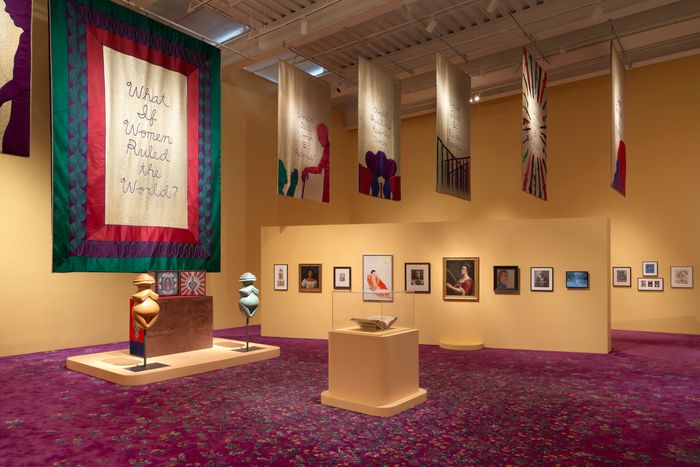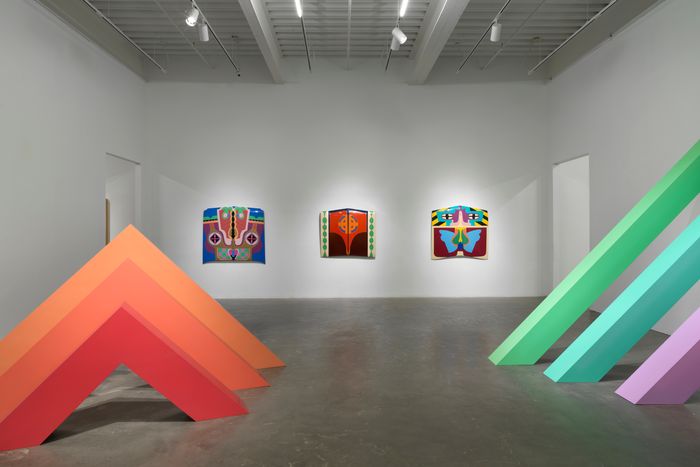
She was a leader in feminist art circles, but sheÔÇÖd never mounted anything quite like this before. The installation was the size of a room, comprising three tables arranged in a triangle and elaborately staged for a meal with 39 places; each was set for a historic woman, such as Hypatia and Emily Dickinson, and included an embroidered banner with their name on it as well as a handpainted ceramic plate. On nearly every plate was an abstracted, aestheticized vulva. On white tiles under the tables were the names of 999 more women, written in gold script.
It took Judy Chicago and about 400 helpers five years to create ÔÇ£The Dinner Party.ÔÇØ It was momentous, an attempt to remake both history and contemporary art in a feminist image, and in the three months after it debuted at the San Francisco Museum of Modern Art in 1979, around 100,000 people came to see it. Many women were deeply moved, leaving appreciative comments in the guest book and sending Chicago fan mail. But not all women: Some noticed that just two of the places were set for people who werenÔÇÖt white ÔÇö Sacagawea and Sojourner Truth, whoÔÇÖs the only figure depicted by a set of faces rather than a vulva. Writing in Ms. in 1979, Alice Walker said that although she ÔÇ£loved ChicagoÔÇÖs art and audacity,ÔÇØ she suspected that ÔÇ£perhaps white women feminists, no less than white women generally, cannot imagine black women have vaginas. Or if they can, where imagination leads them is too far to go.ÔÇØ
Many critics called it kitsch. Men were especially vicious. Robert Hughes of Time wrote that it was ÔÇ£simple, didactic, portentous, gaudily evangelical and wholly free of wit or ironyÔÇØ; to Hilton Kramer of the New York Times, it was ÔÇ£failed art.ÔÇØ Most other U.S. museums that had been scheduled to show the work after SFMOMA canceled their plans. Although Chicago and her friends and supporters managed to find alternate venues, including abroad, the work would end up in storage for decades ÔÇö until 2007, when it went on permanent view at the Brooklyn Museum.
ÔÇ£The Dinner PartyÔÇØ has cast a long shadow over ChicagoÔÇÖs life and career. Although the initial backlash caused her to fall into a deep depression, the artist, now 84, never stopped working, and museums are finally looking at the full arc of her career. ÔÇ£Herstory,ÔÇØ at the New Museum, is the first exhibition to do so in New York. ItÔÇÖs a big show, full of big art and big gestures: early, hefty experiments in minimalist painting and sculpture; canvases filled with floral, vulvar imagery; trippy tapestries; and more. Chicago has worked mostly in series and projects, and even those comprising smaller pieces ÔÇö like ÔÇ£The End: A Meditation on Death and ExtinctionÔÇØ (2012ÔÇô18), which features glowing images of endangered animals and the artistÔÇÖs musings on death, painted on black glass ÔÇö are displayed in groupings. In a way, ChicagoÔÇÖs whole oeuvre feels like a riposte to a society that encourages men to think and work on an epic scale but tells women they must make themselves small. The show affirms how groundbreaking she has been ÔÇö and illuminates how stale ideas from second-wave feminism have lingered, both in her work and in the mainstream.
Born Judith Cohen in 1939, Chicago came up in 1960s Los Angeles, studying art at UCLA. The scene was dominated by men, both in terms of who got to show their work and the kind of work that got shown: polished, sometimes ethereal abstraction that privileged form over content. Its mostly white-male makers, like Larry Bell and Robert Irwin, believed, wrongly, that the art they created was above the fray of subjectivity. In an effort to fit in, Chicago adopted more masculine attire and habits, including smoking cigars and attending motorcycle races; she went out drinking with the guys, but, according to the ÔÇ£HerstoryÔÇØ catalogue, ÔÇ£more often than not, she went home and criedÔÇØ afterward because of how misogynistic they were. In the studio, she attempted to merge the biomorphic forms and soft colors that grew out of her lived experiences with the glossy, implacable surfaces and nonrepresentational forms of minimalism. These experiments were largely rejected by her professors and by dealers from the famous Ferus Gallery as too feminine. At the New Museum, where they form the entry point of the show, theyÔÇÖre some of the most exhilarating work.
In the first gallery, two installations line up painted beams of stainless steel in chromatic and physical ascension ÔÇö geometric rainbows that seem to poke fun at the self-seriousness and machismo of her peers. They frame a set of three wall-mounted ÔÇ£HoodsÔÇØ (1964ÔÇô65/2011), eye-popping compositions of vulvar, phallic, and geometric shapes spray-painted on car hoods. (After finishing her masterÔÇÖs at UCLA, Chicago enrolled in auto-body school to learn spray-painting; she was the only woman among 250 men.) I found myself laughing appreciatively at the double entendre ÔÇö the automotive hood and the clitoral one ÔÇö and delighting in their symmetrical, Surreal imagery and clashing palettes, with strong doses of pink and red. The paintings, psychedelic Rorschach tests, seem to foreshadow the brashness of ÔÇ£The Dinner Party.ÔÇØ
As the ÔÇÖ60s gave way to the ÔÇÖ70s, Chicago began to embrace her feminist consciousness and adopted her new moniker ÔÇö a way of ÔÇ£divest[ing] herself of all names imposed upon her through male social dominance,ÔÇØ as she announced in an ad in Artforum. She founded the first college-level feminist art program in the country and began making her ÔÇ£AtmospheresÔÇØ works by releasing colored flares and smoke into natural landscapes, liberating color along with herself. She started to home in on abstracted representations of female genitalia as a symbol of empowerment. Chicago and her colleague Miriam Schapiro, who made feminist collages that she dubbed ÔÇ£femmages,ÔÇØ called this ÔÇ£central core imagery.ÔÇØ
IÔÇÖve long been hesitant about that imagery, wondering about the exclusions suggested by its literalness. It seems, like a pussy hat, to premise womanhood on organs alone. But the central core work in ÔÇ£HerstoryÔÇØ is more free-floating than that, and terrific: Paintings like Through the Flower and Heaven Is for White Men Only (both 1973) are luminous, transcendent, spiritual. The Rejection Drawings (1974) contain vulnerable, handwritten confessions. ÔÇ£In these images, I discarded my formalized structure for the first time and in so doing, broke through into a new form language,ÔÇØ Chicago writes in Rejection Fantasy Drawing, her text interspersed with renderings of layered vulvas that transform into caves and then butterflies. ÔÇ£But, in breaking through, I became frightened by the prospect of my new loneliness and the difficulty of going on from here.ÔÇØ
Things would not get easier as Chicago undertook ÔÇ£The Dinner PartyÔÇØ ÔÇö which is represented only minimally at the New Museum, in the form of line drawings for the place settings and test plates; it did not leave the Brooklyn Museum. The installation deserves recognition for the scale of what it achieved: all the women it highlights, its huge network of collaboration, its formal invention. Chicago and her volunteers reclaimed, within the realm of art, crafts that had been denigrated as womenÔÇÖs work, such as porcelain painting, ceramics, and needlework. She pulled off a similar feat with the ÔÇ£Birth ProjectÔÇØ (1980ÔÇô85), a similarly collaborative, research-heavy effort to represent the experiences of birth and motherhood in needlework. The five stunning, monumental tapestries from the project that are included at the New Museum mark a turning point in ChicagoÔÇÖs career: Amid their swirling, cosmic landscapes, bodies reach out and writhe ÔÇö a signal of her imminent shift from abstraction to figuration.
The projects that followed are not as successful. ChicagoÔÇÖs embrace of a more figurative, populist style also made her work more literal, weighing it down. Huge paintings from the ÔÇ£PowerPlayÔÇØ series (1982ÔÇô87) feature a white man peeing on the Earth and spraying blood from his hand pointed like a gun, a blunt caricature of toxic masculinity. In the ÔÇ£Holocaust ProjectÔÇØ (1985ÔÇô93), Chicago and her husband, Donald Woodman, present painted, pained figures alongside screenprinted reproductions of photographs from the Holocaust, but itÔÇÖs not clear what deeper purpose all the anguished imagery is meant to serve. I found myself missing the playfulness of the earlier work. Although Chicago is a master at creating fascinating visual effects in whatever medium she adopts, a kind of simplistic thinking creeps up, one that reduces complex subjects to overdetermined morals and dichotomies. It bogs down the culmination of ÔÇ£HerstoryÔÇØ: a magenta-carpeted mini-exhibition on the museumÔÇÖs fourth floor titled ÔÇ£The City of Ladies.ÔÇØ
Inspired by and named after a book by the French medieval writer Christine de Pizan, ÔÇ£The City of LadiesÔÇØ is described as ChicagoÔÇÖs ÔÇ£personal museum,ÔÇØ with art and artifacts by almost 90 women, including a 12th-century manuscript by the visionary theologist Hildegard von Bingen and the bronze maquette for Augusta SavageÔÇÖs 16-foot-tall harp sculpture Lift Every Voice and Sing, which was destroyed after being displayed at the 1939 WorldÔÇÖs Fair. Hanging above is a series of banners that Chicago created at the behest of the fashion brand Christian Dior, as part of the set for a haute couture show in 2020. Titled ÔÇ£The Female Divine,ÔÇØ they pose a series of questions, starting with ÔÇ£What If Women Ruled the World?ÔÇØ and follow-ups like, ÔÇ£Would There Be Violence?ÔÇØ The banners are elegant. The queries border on inane. Representing a way of thinking that imagines women to be inherently, magically good, the project feels painfully outdated.
ÔÇ£The City of LadiesÔÇØ recalls ÔÇ£The Dinner Party,ÔÇØ both in its acknowledgment that no artist works in a vacuum and in its reductiveness. The earlier work falls into the trap of the second wave in its emphasis on gender as the source of oppression for all women, with an unwitting focus on whiteness and middle-class experience. The people in ÔÇ£The City of LadiesÔÇØ are more racially diverse ÔÇö this time, Sojourner Truth is represented by one of her famous calling cards ÔÇö and brief biographies are provided for each. Wrapped in the banners of ÔÇ£The Female Divine,ÔÇØ with ChicagoÔÇÖs goddess figures standing sentinel, they feel flattened nonetheless. These portraits and self-portraits, abstract paintings and craftwork, are slotted into a heavy-handed narrative in service of a feminism that still canÔÇÖt seem to see past itself. Not all of womenÔÇÖs work is about womanhood. Chicago ÔÇö who spent so much of her career pigeonholed ÔÇö should know.


